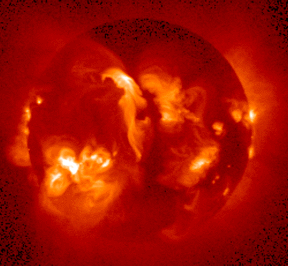





 Image Credit: The solar x-ray images are from the Yohkoh mission of ISAS, Japan. The x-ray telescope was prepared by the Lockheed Palo Alto Research Laboratory, the National Astronomical Observatory of Japan, and the University of Tokyo with the support of NASA and ISAS. |
After only 8 minutes ....X-ray and ultraviolet light given off by solar flares arrives at the Earth. These types of light are responsible for the formation of the ionosphere under normal circumstances. But now the intensities of these types of light have increased dramatically. All over the dayside hemisphere, the ionosphere is increased in density particularly at low altitudes in the D and E regions. This is called a sudden ionospheric disturbance (SID) and lasts usually for between 10 and 60 minutes. Short wave radio signals experience increased absorption when ionization is produced at these low altitudes. Loss of signal at this time is called a short wave fadeout. Enhanced levels of solar radiation can also cause heating and expansion of the neutral atmosphere and increase the amount of atmospheric drag that a satellite experiences in an unpredictable manner. |
The source of this material is Windows to the Universe, at http://windows2universe.org/ from the National Earth Science Teachers Association (NESTA). The Website was developed in part with the support of UCAR and NCAR, where it resided from 2000 - 2010. © 2010 National Earth Science Teachers Association. Windows to the Universe® is a registered trademark of NESTA. All Rights Reserved. Site policies and disclaimer.